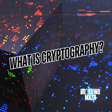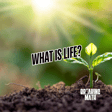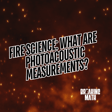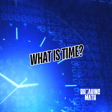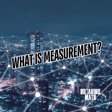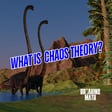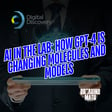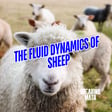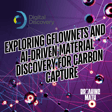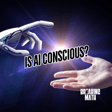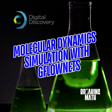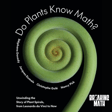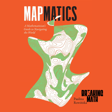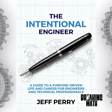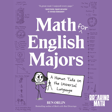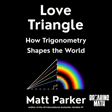Introduction to 'Breaking Math' and the Intersection of Math, Science, and Mystery
00:00:00
Speaker
Welcome to Breaking Math, the podcast where we explore the unexpected intersections between mathematics, science, and the mysteries that fascinate us all. I'm your host, Autumn Feneff.
Victorian Era's Scientific Inquiry into Séances and Communication with the Dead
00:00:10
Speaker
Today we're stepping into an era of strange experiments in visible forces and scientific minds that ventured beyond the known world.
00:00:18
Speaker
We're talking about the Victorian period, where séances, ghosts, and the supernatural weren't just tabloid fought. They were part of very serious scientific inquiry. Believe it or not, some of the greatest minds, yes, those names that you've heard about in textbooks, tried to communicate with the dead. Can you imagine Michael Faraday, the man behind the laws of electromagnetism, sitting in a séance, hands on the table, trying to figure out whether the spirits were pushing it?
19th-Century Spiritualism vs. Electromagnetism: A Social and Intellectual Movement
00:00:46
Speaker
or Nobel Prize winners like Pierre and Marie Curie, participating in experiments with mediums, witnessing tables float and objects fly. These aren't the stories we usually associate with groundbreaking scientific achievements, but they are very real and part of the fascinating history of science's flirtation with the supernatural.
00:01:08
Speaker
In the 19th century, spiritualism wasn't just a niche belief system. It was a full-blown social and intellectual movement. People were hungry for answers about what happens after we die, and they believed that science might hold the key.
00:01:24
Speaker
and Why not? Scientists had already unraveled the mysteries of a electricity and magnetism, forces you couldn't see, but that were undeniably real. Could the same be true for spirits? But here's where it gets really interesting. This wasn't just a fringe interest.
Scientific Investigations into Paranormal Experiences: Potential Discoveries?
00:01:44
Speaker
This was mainstream. In fact,
00:01:46
Speaker
Many scientists believe that paranormal experiences might just be part of the next great discovery, waiting to be understood through experimentation. They were willing to roll up their sleeves and investigate seances, telepathy, and even ghost photography using the same rigorous methods they applied to electricity or magnetism.
00:02:08
Speaker
They thought, if electricity can exist, why not ghosts?
Stories of Scientists like William James and Alfred Russell Wallace and Their Supernatural Curiosity
00:02:12
Speaker
We're going to dive deep into the stories of scientists, like William James, one of the founders of American psychology, who believed that there was more to the mind than what meets the eye. Or Alfred Russell Wallace, co-discoverer of Natural Selection, who argued that evolution hinted at spiritual dimensions. These are stories of belief, skepticism, and the enduring human curiosity for what happens after death. So grab a blanket and settle in. Whether you're a skeptic, a believer, or somewhere in between, today's episode will change how you think about the boundaries of science. Were these scientists simply chasing ghosts, or were they onto something deeper? Join me as I unravel the bizarre and fascinating history of Victorian ghost hunters,
00:02:59
Speaker
and how their experiments laid the groundwork for the understanding of the mysteries of the human mind. In the mid-19th century, Victorian society became increasingly fascinated with
The Fox Sisters and the Scientific Fascination with Spiritualism
00:03:10
Speaker
spiritualism. It was a time of rapid scientific and industrial achievements.
00:03:14
Speaker
But it was also a period where people sought to understand the mysteries of life beyond death. The spiritualist movement gained momentum after the Fox sisters in America claimed to communicate with spirits through mysterious knocking sounds known as rapping. This phenomenon captivated public attention. And soon, sances became a popular social activity, especially in Britain and the United States. The rise of spiritualism wasn't just confined to the public.
00:03:42
Speaker
It also intrigued intellectuals and scientists who were grappling at the idea that there might be unseen forces at work. At the time, when electromagnetism and other invisible forces were being discovered, the possibility that spirits could be part of these new scientific revelations seemed plausible to many. Even prominent scientists, who typically dealt with material facts, found themselves intrigued by the possibility of communicating with the dead.
Michael Faraday's Debunking of Table-Turning Phenomena
00:04:12
Speaker
where participants would place their hands on the table and wait for it to move, was a particularly common method in seances. It was said that the movement of the table signaled communication with spirits. In this atmosphere of curiosity and skepticism, scientists stepped in to investigate the validity of such claims. Some hoped to prove a supernatural origin, while others sought to debunk the phenomenon as natural or fraudulent.
00:04:39
Speaker
The appeal of spiritualism went beyond scientific curiosity. For many, it provided a comforting belief in life after death, particularly for those mourning loved ones. This blend of hope, grief, and scientific inquiry created a perfect storm for spiritualism to flourish during the Victorian era. One of the most famous scientists to investigate spiritual phenomenon was Michael Faraday, renowned for his groundbreaking work in electromagnetism and electrochemistry. In the 1850s, as table turning séances became increasingly popular, Faraday felt compelled to use his scientific knowledge
00:05:18
Speaker
to investigate whether there was any truth to the supernatural claims. Faraday, ever the empiricist, approached investigations with skepticism. Faraday conducted a series of experiments to determine if the table's movement was truly caused by spirits.
00:05:35
Speaker
or by something more mundane. His experiments revealed that participants in these seances were unknowingly moving the table themselves through tiny muscle movements, a psychological phenomenon now known as the idiom motor effect. Faraday published his findings in The Times in 1853, explaining that the unconscious movements of the participants were responsible for the phenomenon, not spirits from beyond the grave.
00:06:03
Speaker
The idiomotor effect, which Faraday essentially discovered during his investigations, describes the involuntary muscle movements that occur when people believe that they are witnessing supernatural events. This discovery helped demystify a wide range of so-called supernatural experiences, including not just table turning, but also Ouija boards and pendulum dowsing, which rely on similar unconscious movements.
William Carpenter and the Idiomotor Effect: Debunking Spiritualist Claims
00:06:31
Speaker
Faraday's work was a critical blow to the spiritualist movement's claims of communicating with the spirits through table turning. However, his findings debunked some of the more mechanical aspects of spiritualism. They also showed how easily the human mind could be tricked into believing the supernatural, especially in the highly charged emotional or social settings.
00:06:53
Speaker
Despite Faraday's skepticism, his investigations into table turning were met with a mixed response. Many spiritualists continued to believe in the supernatural explanations. While others were forced to confront the uncomfortable reality,
00:07:09
Speaker
that their experiences were rooted with their own minds rather than in the afterlife. Building on Faraday's work, physiologist William Carpenter developed a more thorough explanation of the idiomotor effect. In his 1852 paper, Carpenter coined the term idiomotor to describe how thoughts or mental processes could produce physical movements without conscious intent.
00:07:34
Speaker
Carpenter argued that many phenomenon attributed to spirits such as dowsing rods, pendulums, and Ouji boards were actually the result of this effect. Carpenter's work was important not only for debunking specific spiritualist claims, but also for advancing the understanding of human psychology. His theory explained how participants could genuinely believe they were experiencing something supernatural, even though they were the ones causing the phenomenon. The idiomotor effect showed how the subconscious mind could guide actions without conscious awareness, leading people to misinterpret these actions as the work of external forces. This explanation had far-reaching implications. It suggested that many supernatural occurrences
00:08:20
Speaker
could be explained by natural psychological processes, not paranormal forces. Carpenter's theory helped shift psychical research towards a more scientific approach, emphasizing the role of the human mind in producing seemingly supernatural events. Carpenter's work was embraced by skeptics, but Carpenter's work was embraced by skeptics but met resistance from the diehard spiritualists, who were reluctant to abandon their beliefs. However, over time, his explanations gained widespread acceptance in scientific circles, and the idiomotor effect remained a well-established concept in psychology today.
00:09:02
Speaker
Despite this, spiritualism continued to thrive, with new phenomenon emerging that kept investigators like Carpenter busy. His work, though crucial in debunking certain aspects of spiritualism, was just one step in the larger scientific efforts to separate the fact from fiction in the Victorian obsession with ghosts.
Alfred Russell Wallace's Belief in Spiritualism: Scientific Diversity or Misguided Faith?
00:09:23
Speaker
Now, Alfred Russell Wallace, co-discoverer of the theory of natural selection, provides an interesting counterpoint to the skepticism of scientists like Faraday and Carpenter. Wallace was deeply interested in spiritualism and believed it could be reconciled with his scientific views on evolution.
00:09:43
Speaker
Unlike his contemporary, Charles Darwin, Wallace thought that evolution hinted at the existence of a supernatural realm. Wallace argued that human abilities such as language, music, and mathematical reasoning could not be fully explained by natural selection alone.
00:10:00
Speaker
He believed these higher faculties pointed to the influence of a spiritual dimension. For Wallace, spiritualism provided evidence of an unseen world that coexisted with the material one, and he eagerly participated in seances and experiments to communicate with the dead. Wallace's support for spiritualism earned him significant criticism from his peers. Many scientists viewed his beliefs in the supernatural as a betrayal of scientific principles, And it damaged his reputation within the scientific community. However, Wallace remained undeterred, continuing to write articles defending spiritualism and promoting the idea that the human spirit survived after death. One of Wallace's more controversial interests was spirit photography. It practiced that claim to capture images of ghosts. Despite widespread accusations of fraud in spirit photography, Wallace believed that some of the images were genuine.
00:11:00
Speaker
His defense of spirit photography further alienated him from the scientific establishment. In contrast to Faraday and Carpenter, Wallace represents a different strain of Victorian science, one that was open to the possibility that not all phenomena could be explained by the laws of nature. His belief in the supernatural may seem out of place in the set his belief in the supernatural may seem out of place in a scientific career.
00:11:29
Speaker
but it highlights the diversity of thought in the Victorian era's approach to the science
Pierre and Marie Curie's Exploration of Séances: Science vs. Spiritualism
00:11:35
Speaker
and the unknown. We also have the Curies, renowned for their groundbreaking work in radioactivity. They offer a fascinating example of scientists drawn to the paranormal. Pierre and Marie Curie were leaders in uncovering invisible forces through their research on radium and polonium, so it's not surprising they became intrigued by the mysteries of spiritualism.
00:11:59
Speaker
In the early 20th century, the couple attended séances held by the famed medium Eusefia Palladino. These séances were widely discussed in scientific circles, as Palladino was known for producing a variety of supernatural phenomenon, such as levitating tables, eerie sounds, and objects flying across the room. Pierre Curie approached these seances with an open mind, hoping to see if there were any phenomenon that could be explained by known scientific principles. After attending several sessions, Pierre was particularly impressed by Paladino's ability to produce what seemed to be inexplicable events. He admitted that some of the phenomenon he witnessed defied explanation, remarking that the flying objects and moving tables appeared to be more than mere trickery. Marie, on the other hand, was more reserved in her husband's reaction. While she supported her husband's interest in investigating the seances, she never fully endorsed spiritualism. Despite this, after Pierre's tragic death in a carriage accident in 1906, Marie began writing letters to him in her diary, addressing him as if he were still alive. These letters suggested that, at least on a personal level, Marie entertained the idea of communicating with the dead.
00:13:21
Speaker
though she never publicly aligned herself with spiritualist beliefs. The Curie's involvement with spiritualism highlights a key theme of the Victorian and early 20th century scientific community, the willingness to explore the unknown, even if it bordered on the supernatural.
00:13:39
Speaker
While the Curies ultimately contributed far more to physics and chemistry than to psychical research, their participation in seances exemplifies how the boundaries between science and spiritualism were blurred in this area.
00:13:52
Speaker
However, not all their contemporaries were convinced. Many skeptics viewed Palladino's seances as a form of stage magic rather than genuine supernatural occurrences. Magicians and illusionists often debunked mediums like Palladino, demonstrating how they used hidden wires, clever props, and the sleight of hand to create the illusion of ghostly phenomenon.
William James and Open-Minded Inquiry into Spiritualism
00:14:16
Speaker
But then there was also William James.
00:14:19
Speaker
known as the father of American psychology. He was one of the most prominent scientists involved in the investigation of spiritualism. Unlike Faraday and Carpenter, who primarily sought to debunk supernatural claims, James took more of an open-minded approach. He believed that there were more aspects you believe that there were aspects to the human consciousness that science had yet to understand, and he was willing to entertain the possibility that some paranormal phenomenon could be real. James was a founding member of the American Society for Psychical Research.
00:14:54
Speaker
an organization dedicated to the scientific study of spiritualism and other paranormal events. He was particularly interested in telepathy, apparitions, and mediumship. One of the most famous mediums he studied was Leonora Piper, whom he believed to possess genuine psychic abilities.
00:15:13
Speaker
Over many years of observations, James concluded that while there was a significant amount of fraud in the world of spiritualism, Piper's abilities could not be easily ah explained away by trickery. His belief in the possibility of the paranormal was not blind. James was fully aware of the fraud that plagued spiritualism. Many mediums were exposed as charlatans using hidden accomplices or a simple sleight of hand to convince people that they were communicating with the dead.
00:15:41
Speaker
However, James argued that the prevalence of fraud did not invalidate the entire field. Just because some mediums were fraudulent, it didn't mean that all paranormal phenomenon could be dismissed outright. James's work laid the foundation for future scientific inquiry into the paranormal, helping to create a space where such phenomenon could be studied systematically.
00:16:05
Speaker
He believed that psychic experience, whether they turned out to be real or not, could reveal important truths about the human mind and consciousness. James' legacy in psychical research had persisted into the modern era, which with contemporary scientists continuing to explore the boundaries of psychology and the unknown.
00:16:25
Speaker
Ultimately, William James embodied the scientific curiosity of the Victorian era, where the line between the scientific and the supernatural was often blurry. His willingness to consider the paranormal as a legitimate era of study shows that for many scientists of the time, the desire to explore the unknown often outweighed the fear of ridicule or skepticism from their
Sidgwick's Debunking of Fraudulent Claims and Women in Science
00:16:48
Speaker
peers. Now, Eleanor Sidgwick, a prominent mathematician and researcher, played a crucial role in shifting psychical research towards a more skeptical and scientific approach. As a key feature in the Society for Psychical Research, s Sidgwick's investigation focused on debunking fraudulent mediums and spirit photographers.
00:17:08
Speaker
Her work was instrumental in dismantling some of the sensational claims of spiritualism, particularly the belief that photographs could capture images of ghosts. Sidgwick meticulously examined spirit photographs, which purported to show ghostly apparitions hovering around living subjects. These images were often produced during seances.
00:17:31
Speaker
And many believers took them as proof of life after death. However, Sidrix's investigation revealed that most of these photographs were the result of double exposure or other photographic tricks. She demonstrated that photographers were using techniques such as projecting images onto plates.
00:17:51
Speaker
are manipulating light sources to create the illusion of spirits. Despite her skepticism, Sidric was not entirely dismissive of paranormal phenomenon. She left room for the possibility that telepathy or thought transference could be real. Her careful balanced approach helped to establish a more rigorous standard for investigating psychic claims.
00:18:13
Speaker
Rather than simply dismissing all paranormal phenomenon as fraud, Sidric advocated for a scientific method that could separate genuine phenomenon from deception. Sidric's work also highlights the role of women in the scientific investigation of spiritualism, which was often dominated by male figures like Faraday, Carpenter, and James.
00:18:35
Speaker
As one of the few women in psychical research, Sidgwick's contributions were critical in steering the field away from sensationalism and towards more credible scientific inquiry. Her legacy in this regard is significant, as she helped lay the groundwork for future investigations into the paranormal, ensuring that such studies were conducted in the same rigor as any other scientific discipline.
00:19:00
Speaker
Ultimately, Eleanor Sidgwick's contributions to psychical research show that skepticism and open-mindedness are not mutually exclusive. While she debunked many fraudulent claims, she remained curious about the potential for real psychic phenomenon making her an important figure in the scientific study of the
Victorian Science: The Blurred Line Between Science and Superstition
00:19:20
Speaker
supernatural. The investigations of Victorian scientists into the paranormal offer a fascinating glimpse into a period when the boundaries between science and supernatural were less clearly defined.
00:19:33
Speaker
Figures like Faraday, Carpenter, and Sidgwick approached spiritualism with skepticism, using scientific principles to debunk many of the era's most popular supernatural claims. Their work demonstrated that phenomenon, like table turning and spirit photography, were often the result of unconscious movements or fraudulent manipulation rather than genuine communication with the dead.
00:19:56
Speaker
On the other hand, scientists like Wallace and James were more open to the possibility that some paranormal experiences could be real. They believed that spiritualism, if studied carefully, might reveal new insights into the nature of human consciousness in the universe.
00:20:14
Speaker
While their openness to the supernatural earned them criticism from their peers, their work helped to expand the scope of scientific inquiry, pushing the boundaries of what was considered acceptable research. The Victorian era's obsession with spiritualism also reflects cultural anxieties about death.
00:20:33
Speaker
the afterlife, and the limits of human knowledge. At a time where science was rapidly advancing, many people found comfort in the idea that the dead could still communicate with the living. Spiritualism provided a way to reconcile the growing power of science with the enduring mysteries of existence. The investigations of Victorian scientists into ghosts and spirits were about more than just debunking frauds or proving the existence of supernatural.
00:21:01
Speaker
They were part of a large request to understand the unknown, to push the boundaries of what scientists could explain. Today, these investigations remind us that science is not just about solving puzzles. It's also about exploring the mysteries that lie beyond the current understanding.
00:21:17
Speaker
It's clear that the Victorian era wasn't just about science versus superstition. It was a time of curiosity, open minds, and a willingness to explore the unknown. Whether they were debunking hoaxes or truly believing in the possibility of the supernatural, the scientists we've talked about today, Faraday, the Curies, William James, and Alfred Russell Wallace,
00:21:40
Speaker
Remind us that the quest for the knowledge often starts with a question that seems beyond the reach of logic. And while many of these ghostly investigations didn't lead to proof of spirits, they did lead to real scientific discoveries. Michael Faraday's exploration of table turning led to the insights of the ideometer effect, which still influences psychology today. And even skeptics like Eleanor Sedgwick,
00:22:07
Speaker
helped push scientific inquiry to be more rigorous and grounded in evidence. Science, after all, is about asking questions and testing the limits of what we know. In a way, the legacy of Victorian ghost hunters is still with us. We're still grappling with big questions about consciousness, the mind, and what happens after we die. While most scientists are far from skeptical of the supernatural now, that same spirit of curiosity is what drives exploration at the edges of our understanding.
00:22:37
Speaker
whether it's the mysteries of the brain or the universe. So whether you're a firm believer in the supernatural or a hard-nosed skeptic, it's worth remembering that even the most brilliant minds in history have had their moments where they've reached into the unknown looking for answers. And sometimes these answers come from the most unexpected places. Thanks for joining me on this eerie exploration of science and the supernatural.
00:23:02
Speaker
If you enjoyed today's episode, don't forget to subscribe, leave a review, and share Breaking Math with your friends. And if you've got a topic that you'd like to explore with us, reach out on social media, our email, or our website. Until next time, keep asking questions and challenging what you think you know. The next great discovery might just be hiding in plain sight.

